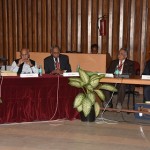Keynote Address on ‘ASEAN Today: Introspection and Prospects’ by Ambassador Rajiv Bhatia, Distinguished Fellow, Gateway House, Mumbai at ‘Regional Conclave on ASEAN@50 and India-ASEAN Relations’ (NIAS, Bengaluru, 7 December 2017). He also gave the Chairman’s Address at the conclave. Read more about the event here.
Key Elements
- Purpose of the Conclave is to celebrate not one but two anniversaries; and, in the process, to reflect on the balance sheet of ASEAN and the grouping’s evolving relationship with India. This will help spread the awareness of issues at the people’s level and also assist in developing fresh ideas for the consideration of policymakers.
- On ASEAN’s journey in the past 50 years (1967-2017), I hold an overall positive view.
It has many achievements to its credit: economic success; contribution to regional security and political architecture; its three ‘C’ formula – Consultation, Compromise, Consensus, and widely perceived success as a regional institution. - However, its failings and underperformance should not be ignored: unity and ‘centrality’ have been eroded; excessive verbosity; often seen as a talking shop; connect with the people is debatable; ASEAN Community is yet to happen; and integration of CMLV is still incomplete.
- The past five years (2012-17) have not been all that good. The SCS issue has cast serious shadows on ASEAN. The next five years will pose a serious challenge.
- On India-ASEAN partnership too, I am positive and optimistic, but this should not prevent us from noting that a significant disconnect exists between the government view and a large chunk of strategic community, media and business: the former believes that the partnership is in excellent shape and has a great future, whereas the latter suggests that rhetoric and declarations surpass action and delivery. Where is the reality? I think it lies somewhere in the middle space. The relationship has progressed reasonably well in the past decade, showing new vitality and vibrancy since November 2014, but its full potential remains untapped.
- What can and should be done? This is the question that must engage all of us fully.
The Way Forward
- Research and analysis without policy advice and recommendations do not help policymakers adequately. So, what do we, the experts assembled here, suggest to Indian and ASEAN policymakers, business leaders and other elites?
- I should propose, for consideration and debate, my three-pronged prescription that may aptly be portrayed as ‘the ASEAN + Policy.’ Main elements as below:
- Intensify cooperation with ASEAN through both the regional track and the bilateral track
- On the regional track, consider afresh the obstacles that hamper trade and investment expansion; accelerate RCEP negotiations; make the utilisation of three Funds more effective and better known; and produce results from the two initiatives announced by the Modi government – $1 billion for digital connectivity with ASEAN countries and $75 million for new projects in CMLV region.
- On the bilateral track, focus on deepening ties with Indonesia, Vietnam and Malaysia.
- Plan a step-by-step rejuvenation and expansion of BIMSTEC by concentrating on
- A few select priority areas for cooperation
- Institutional reforms
- Setting up a BIMSTEC Development Fund
- Inviting Vietnam, Cambodia and Lao Republic into the grouping. When the BIMSTEC membership goes up from 7 to 10, it will reflect a better balance between South Asia and Southeast Asia.
- Within the expanded BIMSTEC, keep strengthening BBIN as the core and leverage its progressive integration to drive BIMSTEC forward.
- Address the changing power dynamics in East Asia through the strategy of vigilance and resilience as spelt out below:
- We all want a stable secure and prosperous East Asia, but not all of us would accept a Sino-centric Asia. Regional unity should be built around multi-polarity and smart balance. This alone will be the bulwark for regional stability.
- While avoiding the perils of military confrontation and Cold War-type containment, India should be pro-active in the further development of and harmonization within the Quadrilateral Grouping or Quad of US, Japan, Australia and India. But this will not be enough.
- Developing the Quad’s strategic communication with other nations – Indonesia, Vietnam, Thailand and South Korea – should be an immediate goal, and
- India’s Act East Policy should operate within the larger Indo-Pacific framework.
- Intensify cooperation with ASEAN through both the regional track and the bilateral track
Rajiv Bhatia is Distinguished Fellow, Foreign Policy Studies, Gateway House
You can read exclusive content from Gateway House: Indian Council on Global Relations, here.
For interview requests with the author, or for permission to republish, please contact outreach@gatewayhouse.in.
© Copyright 2017 Gateway House: Indian Council on Global Relations. All rights reserved. Any unauthorized copying or reproduction is strictly prohibited


